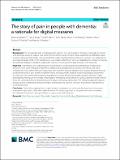| dc.contributor.author | Patrascu, Monica | |
| dc.contributor.author | Berge, Line I. | |
| dc.contributor.author | Vahia, Ipsit V. | |
| dc.contributor.author | Marty, Brice | |
| dc.contributor.author | Achterberg, Wilco P. | |
| dc.contributor.author | Allore, Heather | |
| dc.contributor.author | Fletcher, Richard R. | |
| dc.contributor.author | Husebo, Bettina S. | |
| dc.date.accessioned | 2025-08-25T17:46:53Z | |
| dc.date.available | 2025-08-25T17:46:53Z | |
| dc.date.issued | 2025-04-17 | |
| dc.identifier.uri | https://hdl.handle.net/1721.1/162477 | |
| dc.description.abstract | Background The increasingly older world population presents new aging-related challenges, especially for persons with dementia unable to express their suffering. Pain intensity and the effect of pain treatment are difficult to assess via proxy rating and both under- and overtreatment lead to neuropsychiatric symptoms, inactivity, care-dependency and reduced quality of life. In this debate piece, we provide a rationale on why valid digitalization, sensing technology, and artificial intelligence should be explored to improve the assessment of pain in people with dementia. Main text In dementia care, traditional pain assessment relies on observing the manifestations of typical pain behavior. At the same time, pain treatment is complicated by polypharmacy, potential side effects, and a lack of around-the-clock, timely measures. But proper pain treatment requires objective and accurate measures that capture both the levels of pain and the treatment effects. Sensing systems research for personalized pain assessment is underway, with some promising results regarding associations between physiological signals and pain. Digital phenotyping, making use of everyday sensor data for monitoring health behaviors such as patterns of sleep or movement, has shown potential in clinical trials and for future continuous observation. This emerging approach requires transdisciplinary collaboration between medical and engineering sciences, with user involvement and adherence to ethical practices. Conclusion Digital phenotyping based on physiological parameters and sensing technology may increase pain assessment objectivity in older adults with dementia. This technology must be designed with user involvement and validated; however, it opens possibilities to improve pain relief and care. | en_US |
| dc.publisher | BioMed Central | en_US |
| dc.relation.isversionof | https://doi.org/10.1186/s12916-025-04057-3 | en_US |
| dc.rights | Creative Commons Attribution | en_US |
| dc.rights.uri | https://creativecommons.org/licenses/by/4.0/ | en_US |
| dc.source | BioMed Central | en_US |
| dc.title | The story of pain in people with dementia: a rationale for digital measures | en_US |
| dc.type | Article | en_US |
| dc.identifier.citation | Patrascu, M., Berge, L.I., Vahia, I.V. et al. The story of pain in people with dementia: a rationale for digital measures. BMC Med 23, 227 (2025). | en_US |
| dc.contributor.department | Massachusetts Institute of Technology. Department of Mechanical Engineering | en_US |
| dc.relation.journal | BMC Medicine | en_US |
| dc.identifier.mitlicense | PUBLISHER_CC | |
| dc.eprint.version | Final published version | en_US |
| dc.type.uri | http://purl.org/eprint/type/JournalArticle | en_US |
| eprint.status | http://purl.org/eprint/status/PeerReviewed | en_US |
| dc.date.updated | 2025-07-18T15:34:19Z | |
| dc.language.rfc3066 | en | |
| dc.rights.holder | The Author(s) | |
| dspace.date.submission | 2025-07-18T15:34:19Z | |
| mit.journal.volume | 23 | en_US |
| mit.license | PUBLISHER_CC | |
| mit.metadata.status | Authority Work and Publication Information Needed | en_US |
